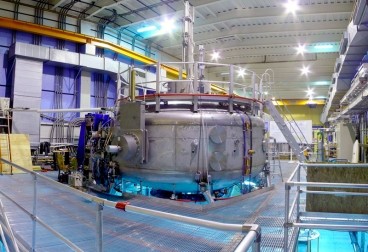ITER NEWSLINE
116
Space inspires fusion on earth
Space inspires fusion on earth

The Levitated Dipole Experiment on the MIT campus.
The new results published there come from an experimental fusion reactor at the Plasma Science and Fusion Centre on the MIT campus, inspired by observations from space made by satellites. Called the Levitated Dipole Experiment, or LDX, a joint project of MIT and Columbia University, it uses a half-tonne donut-shaped magnet about the size and shape of a large truck tire, made of superconducting wire coiled inside a stainless steel vessel. This magnet is suspended by a powerful electromagnetic field, and is used to control the motion of the 10-million-degree-hot electrically charged gas, or plasma, contained within its 16-foot-diameter outer chamber.
Our experiment was inspired by observations of planetary magnetospheres made by interplanetary spacecraft," says MIT senior scientist Jay Kesner. "Planets like Earth and Jupiter can accumulate hot ionized matter with their dipole field even at high pressure," says the physicist. A plasma effect known as turbulent inward pinch.
Read the MIT press release here
return to Newsline #116


